HEARTS OF COMPASSION
revisiting our undervalued culture
7/30/2024
Last year, I got a text message from my dear friend, Mitali. She was planning to travel back to her home in India for her sister’s wedding. Because she knew how desperately I wanted to attend her wedding back in 2020 and how sad I was to miss it, she invited me to her sister’s wedding in November! Not only would I get to see my best friend in her mother country, but I would redeem myself from missing her wedding! Attending an Indian wedding was one of my dreams, so I was so excited to say YES. Luckily, traveling to India from Korea was much cheaper than from the States. An 11 hour flight isn’t bad, right?
November came before I realized, and David and I arrived with butterflies flying in our hearts. Mitali and her family (meaning her parents, grandparents, aunts, uncles, cousins, nephews, and nieces, etc) welcomed us to their place. From 7am to 1am we drank homebrewed chai, which, I’m convinced, is why I stayed so healthy during the trip. Before the trip, Mitali told us to just bring a couple of formal shirts for the wedding, but we quickly realized the party demanded something more than ‘formal shirts.’ We needed at least five different outfits with color coordinations! As devout Hindus, the bride and her husband planned traditional rituals. Imagine how fun it would be to go through these outfits: a green dress for Mehndi (henna party), a lehenga two-piece for Roka (engagement party), another lehenga for Sangeet (dance party), a yellow outfit for Haldi (blessing party), and a saree for the final wedding ceremony. We didn’t know what we signed up for, but we were so ready.


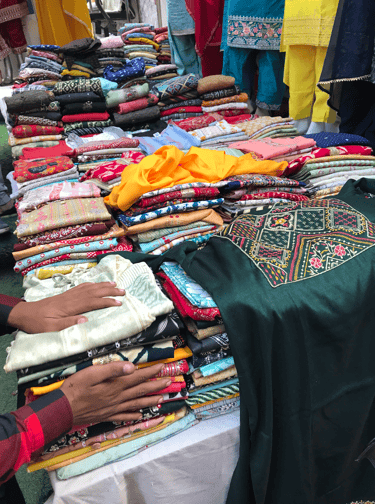

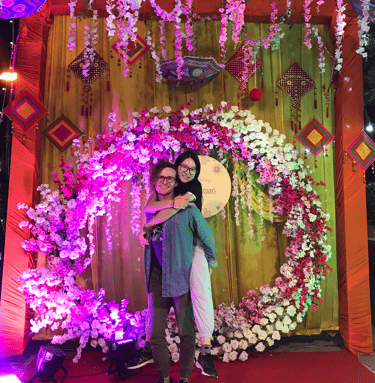

shopping for wedding outfits!
The wedding took 4 days with pre-wedding rituals. Mehndi, typically hosted by the bride's family, started off the wedding by inviting families to gather and apply beautiful patterns of henna on their hands. The color green is generally worn which gave me the feeling of the new nature of life beginning.
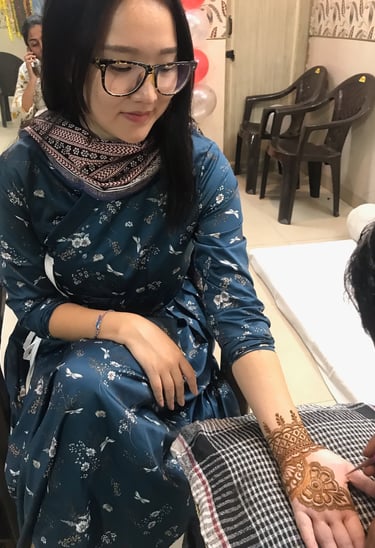

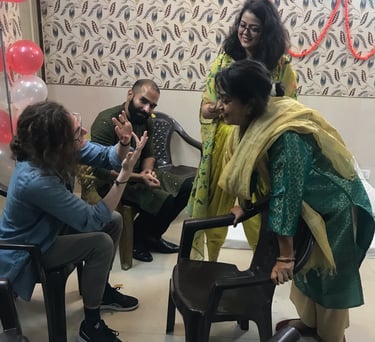

Varieties of pink and yellow were worn for Roka, an engagement party where two families exchange gifts and sweets. Yellow marigolds are believed to attract divine energy and were used during this ceremony. Everyone surrounded the bride and groom and sprinkled a handful of marigold petals over them.
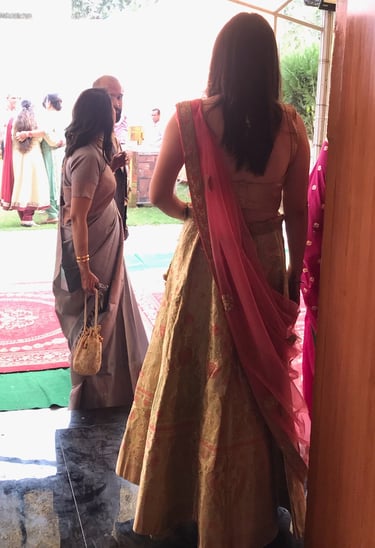

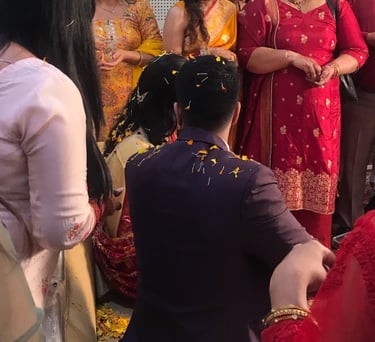



Sangeet took place a couple hours after Roka, and a variety of blue and green were worn. This was bollywood coming true! Families coming together and dancing! The bride and her siblings choreographed a dance show, and you know I’m not a dancer haha, but it was so cool how dance was such a joyful part of ritual that everyone excitedly anticipated!
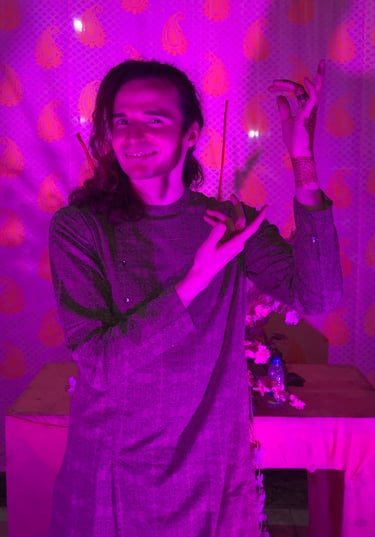



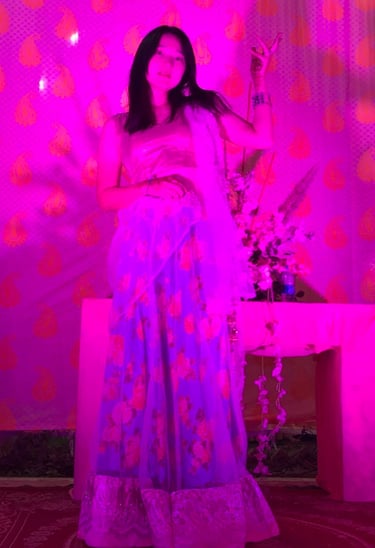

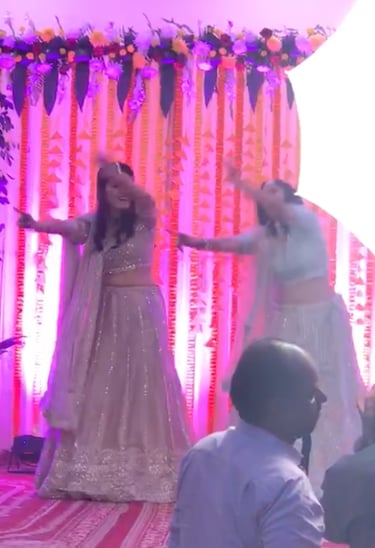

Gold, gold, gold everywhere! The Haldi ritual felt very sacred to me. Haldi means turmeric in Hindi, and the deep goldish orange color filled the atmosphere. Everyone wears an orange or yellow outfit, and applies turmeric paste on the bride and groom’s face. Just like Roka, embodying the couple in sacred color and participating in physical practice were incredibly inviting.
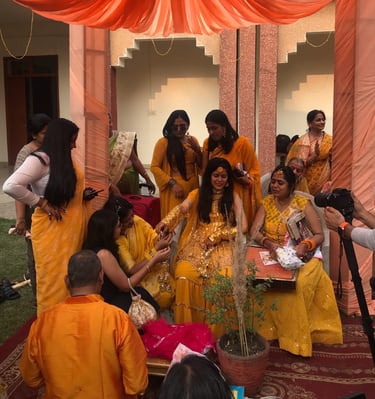

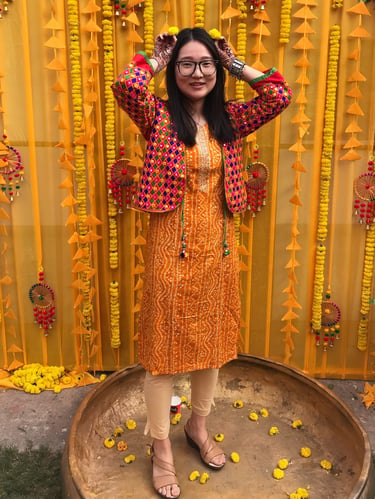





Everyone wore their best outfit to the final wedding ceremony. The bride wore bright red, and guests wore silky “blingeee” attires. It definitely was a celebration time. The groom entered the venue on a flower decorated horse carriage, and people greeted him with dancing and rhythmical music.
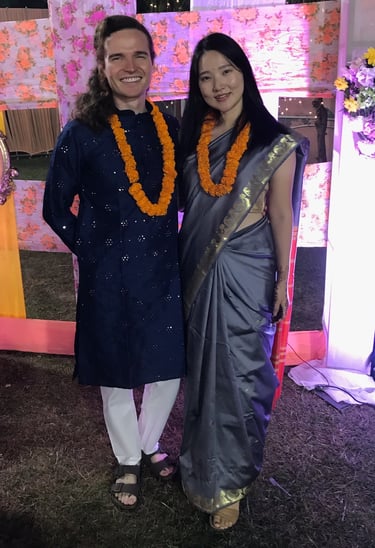


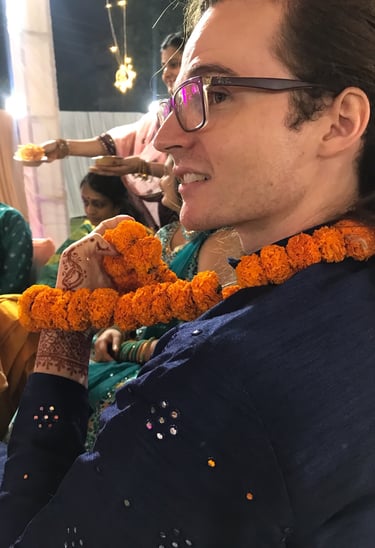

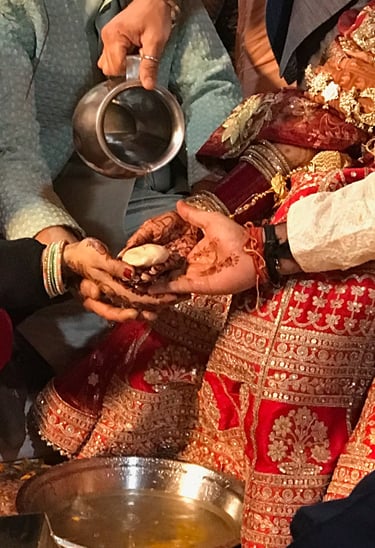

Even though I’m a big fan of simple and modern taste, I couldn’t stop appreciating how important color was treated in the Indian wedding. Yes, black and white is my favorite color combination, but do they really represent joy and celebration of two people coming together? For the final ceremony, the bride and her family wore bright red outfits which was not new to me. Many Asian brides wore dresses with red accents traditionally. Red represents vibrant life, passionate love and protection against evil.
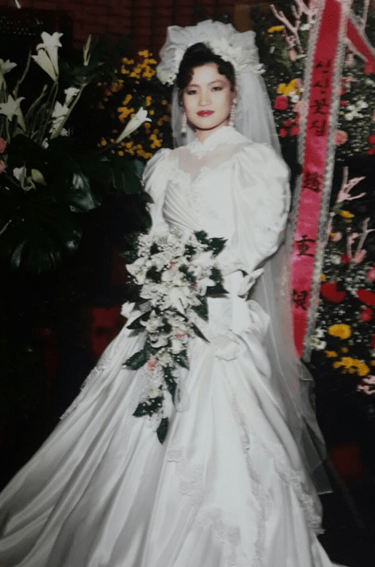

My grandmother would have worn a colorful dress for her wedding, but I know my mom had a white gown with crazy shoulder pads on her wedding day. What happened in between my grandmother and mother’s generation? White wedding gowns were first introduced to Japan. Japan treated westernized attire as social progress and introduced this clothing culture to Korea and other countries that they were occupying. In 1962, South Korea was recovering from the war and kicking off with rapid financial growth plans. The new republic looked to other wealthy western countries for financial development plans, and the white wedding dress trend developed as well.


Korean Bride by Elizabeth Keith(1938)
my mom and her wedding dress(1988)
In some ways the Indian wedding gave me a bit of culture shock and jealousy. The ceremonies invited us to participate in such artistic ways. They invited us to put on vibrant fabrics, to wear intricate patterns of henna, to sprinkle sacred flowers, to dance in rhythmical music. Even under the colonization of Britain, India preserved their beautiful, long history of tradition. What could have helped Korea to preserve their culture? I feel loss over how my ancestors’ beautiful and colorful wedding dress became literally whitewashed. It makes me wonder how we can value our own culture before accepting a wealthier, dominant culture, including Christianity.
In the book Culture Care by Makoto Fujimura, the author's main message is this: culture is not a territory to be won or lost but a resource we are called to steward with care (I hope seeing how his ancestors failed to do so and how much Korean culture was lost during Japanese occupation would have inspired him in this writing). It took me over 10 years of living in the heart of western culture to look back into my own culture and art. I was too busy shaping myself into a likable figure in the US other than offering what I had. No wonder why my mom told me that I’m not Korean anymore. Yes, we change as the seasons change, but perhaps value for our undervalued cultures can deepen with the seasons.
Recently I listened to Fuller’s chapel celebrating Black History Month, and found a hopeful answer on how to do so. Dr. Goatley, the president of Fuller, shared a profound insight which I think is a key to this culture-care. He said: “May we grow in the kind of faith of Jesus. That gives us hearts of compassion, hands of collaboration, heads of creativity, and souls that are convinced that Jesus actually makes a difference.” When we encounter unfamiliar cultures, let’s take a time to see the beauty in them. Let’s, with compassion, learn from them. Let’s reach our hands to be connected. I believe if Japanese and westerners viewed Korean culture and art with compassion, and collaborated with their own culture creatively, my mom would have worn a red dress.

I dream about a world that would not treat culture as a territory to be won. A world where dominant and subordinate cultures come together. God has promised in Isaiah 11 that it shall come, “The wolf will live with the lamb, and the leopard will lie down with the goat. The calf, the young lion, and the fatling will be together, and a child will lead them. The cow and the bear will graze, their young ones will lie down together, and the lion will eat straw like the ox. An infant will play beside the cobra’s pit, and a toddler will put his hand into a snake’s den. None will harm or destroy another on My entire holy mountain, for the land will be as full of the knowledge of the Lord as the sea is filled with water.” May the culture of the wolf and the culture of the lamb be beautified in collaboration without defeat. May the young lion take up the heart of compassion and submissively follow a child’s lead. May the leopard adore the goat’s white fur before showing off their patterns. May the faith in Jesus bring this world on earth through compassion.
On that day, we shall wear bright red, green, blue, and gold wedding dresses.
Would you lovingly pray for Songbird in these ways?
1. David and I only have one more month in the US. Please pray for our travel back to Korea.
2. That I will find a remote, enjoyable part-time job.
3. That I will be mindful of my body and take care of my right shoulder.
4. That I would fix my eyes on Jesus whom gives creativity, compassion, and collaboration.
Nesting Together #3
Did you know that the western tradition of white dress only began in 1840 when Queen Victoria wore white? I want to invite you to imagine what your great x8 grandmother would have worn on her wedding day. What color did your ancestors value? What material is the dress made of? You can do a quick research, or just close your eyes to explore. Take as much time as you want. I ask you to draw out the wedding dress, and send the photo to me (270-243-7565). I'm excited to see your ancestor's dress!
Visiting neighboring nests
Other birds' answers to "what makes you feel at home?"
A garden with a tree and place to sit in quiet
My grandma’s quilts! Also open fields surrounded by hills/mountains
Having patterns hung on the walls and handmade carpets under my feet, make me feel at home.
My family. My husband, my children and my God!
Birdwatcher, birdlover...and birdfeeder!
If you want to support my art journey financially, I want to thank you! Your seed will be a source for me to explore the world of creation, and encourage me to make beautiful things.
Songbird Kreativ
songbirdkreativ@gmail.com